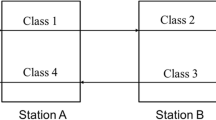Abstract
Asymptotic behavior of queues is studied for large closed multi-class queueing networks consisting of one infinite server station with K classes and M processor sharing (PS) stations. A simple numerical procedure is derived that allows us to identify all bottleneck PS stations. The bottleneck station is defined asymptotically as the station where the number of customers grows proportionally to the total number of customers in the network, as the latter increases simultaneously with service rates at PS stations. For the case when K=M=2, the set of network parameters is identified that corresponds to each of the three possible types of behavior in heavy traffic: both PS stations are bottlenecks, only one PS station is a bottleneck, and a group of two PS stations is a bottleneck while neither PS station forms a bottleneck by itself. In the last case both PS stations are equally loaded by each customer class and their individual queue lengths, normalized by the large parameter, converge to uniformly distributed random variables. These results are directly generalized for arbitrary K=M. Generalizations for K≠M are also indicated. The case of two bottlenecks is illustrated by its application to the problem of dimensioning bandwidth for different data sources in packet-switched communication networks. An engineering rule is provided for determining the link rates such that a service objective on a per-class throughput is satisfied.
Similar content being viewed by others
References
A. Berger and Y. Kogan, Dimensioning bandwidth for elastic traffic high-speed data networks, submitted for publication.
A. Birman and Y. Kogan, Asymptotic evaluation of closed queueing networks with many stations, Commun. Statist. Stochastic Models 8 (1992) 543–564.
W. Feller, An Introduction to Probability Theory and Its Application, Vol. 1, 3rd ed., Revised printing (Wiley, New York, 1970).
M. Freidlin and A. Wentzell, Random Perturbations of Dynamical Systems (Springer, New York, 1984).
F.P. Kelly, The dependence of sojourn times in closed queueing networks, in: Mathematical Computer Performance and Reliability, eds. G. Iazeolla, P.J. Courtois and A. Hordijk (North-Holland, Amsterdam, 1984) pp. 111–121.
Y. Kogan, Another approach to asymptotic expansions for large closed queueing networks, Oper. Res. Letters 11 (1992) 317–321.
Y. Kogan and A. Birman, Asymptotic analysis of closed queueing networks with bottlenecks, in: Performance of Distributed Systems and Integrated Communication Networks, eds. T. Hasegawa, H. Takagi and Y. Takahashi, IFIP Transactions C-5 (North-Holland, Amsterdam, 1992) pp. 265–280.
Y. Kogan and A. Yakovlev, Asymptotic analysis for closed multichain queueing networks with bottlenecks, Queueing Systems 23 (1996) 235–258.
J. McKenna and D. Mitra, Integral representation and asymptotic expansions for closed Markovian queueing networks: Normal usage, Bell Syst. Tech. J. 61 (1982) 661–683.
A.L. Peressini, F.E. Sullivan and J.J. Uhl Jr., The Mathematics of Nonlinear Programming (Springer, New York, 1988).
B. Pittel, Closed exponential networks of queues with saturation: The Jackson-type stationary distribution and its asymptotic analysis, Math. Oper. Res. 6 (1979) 357–378.
Private network-network interface specification, Version 1.0, ATM Forum (March 1996).
Author information
Authors and Affiliations
Rights and permissions
About this article
Cite this article
Berger, A., Bregman, L. & Kogan, Y. Bottleneck analysis in multiclass closed queueing networks and its application. Queueing Systems 31, 217–237 (1999). https://doi.org/10.1023/A:1019110314687
Issue Date:
DOI: https://doi.org/10.1023/A:1019110314687



